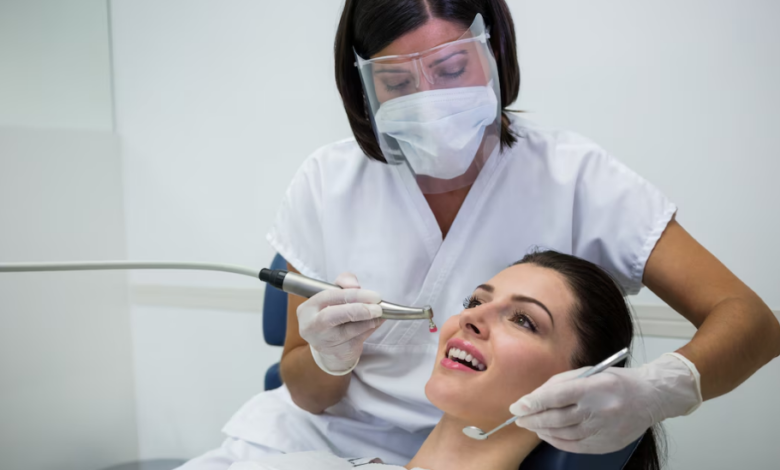Smile Makeover in San Diego: Which Cosmetic Dentistry Treatments Are Right for You?

- Understanding Cosmetic Dentistry Options
- Teeth Whitening Solutions
- Porcelain Veneers for a Flawless Smile
- Dental Implants for Missing Teeth
- Invisalign: A Clear Alternative to Braces
- Bonding and Contouring for Minor Imperfections
- Choosing the Right Cosmetic Dentist in San Diego
- Wrapping It Up
- Frequently Asked Questions
Understanding Cosmetic Dentistry Options
What Is Cosmetic Dentistry?
Cosmetic dentistry is all about improving the appearance of your teeth, gums, and bite. It focuses on things like color, position, shape, size, alignment, and overall smile appearance. It’s not always about fixing health problems, but more about making you feel confident with your smile. It’s a field that combines art and science to create the smile you’ve always wanted.
Benefits of Cosmetic Dentistry
Cosmetic dentistry can do more than just make your smile look better. It can actually boost your self-esteem and confidence. When you’re happy with your smile, you tend to smile more, which can improve your mood and how others perceive you. Plus, some procedures can also improve your oral health.
Here’s a quick rundown of the benefits:
- Improved self-confidence
- Enhanced appearance
- Better oral health in some cases
- Long-lasting results
Cosmetic dentistry isn’t just about vanity; it’s about investing in yourself. A great smile can open doors, both personally and professionally. It’s about feeling good in your own skin and projecting that confidence to the world.
Common Procedures in Cosmetic Dentistry
There are a bunch of different procedures that fall under the umbrella of cosmetic dentistry. Here are some of the most common ones:
- Teeth Whitening: Brightens stained or discolored teeth.
- Porcelain Veneers: Thin shells placed over the front of teeth to fix chips, cracks, or discoloration.
- Dental Implants: Artificial tooth roots used to support replacement teeth.
- Invisalign: Clear aligners used to straighten teeth.
- Bonding and Contouring: Repairs minor imperfections like small chips or gaps.
Each of these procedures has its own set of pros and cons, and the best choice for you will depend on your specific needs and goals. It’s always a good idea to talk to a cosmetic dentist to figure out the right plan for your smile makeover.
Teeth Whitening Solutions
So, you’re thinking about getting your teeth whitened? Awesome! It’s a super common procedure, and honestly, it can make a huge difference in how you feel about your smile. There are a bunch of different ways to go about it, each with its own pros and cons. Let’s break down some of the most popular options.
In-Office Teeth Whitening
In-office whitening is probably the fastest way to get noticeable results. Basically, you go to your dentist, and they use a pretty strong bleaching agent to whiten your teeth. They usually protect your gums and soft tissues first, and then apply the stuff. Sometimes they use a special light to activate the bleach, which can speed things up. The whole process usually takes about an hour or so, and you can see a pretty big difference right away. The downside? It can be a bit more expensive than other methods.
At-Home Whitening Kits
If you’re looking for something a little more budget-friendly, at-home whitening kits might be a good option. You can get these from your dentist or over the counter at most drugstores. The kits usually include a tray that you fill with a whitening gel and wear for a certain amount of time each day. The strength of the bleaching agent is usually lower than what they use in the office, so it takes longer to see results. But, it’s definitely a convenient way to brighten your smile from the comfort of your own home. Just make sure you follow the instructions carefully to avoid any sensitivity.
Choosing the Right Whitening Method
Okay, so how do you pick the right method for you? Well, it really depends on a few things, like your budget, how quickly you want to see results, and how sensitive your teeth are. If you want instant gratification and don’t mind spending a bit more, in-office whitening is probably the way to go. If you’re on a budget and willing to be patient, at-home kits can work well. And if you have sensitive teeth, you might want to talk to your dentist about options with lower concentrations of bleaching agents.
Ultimately, the best thing to do is talk to your dentist. They can evaluate your teeth and gums, discuss your goals, and help you choose the whitening method that’s right for you. They can also give you tips on how to maintain your results and avoid sensitivity. Remember, a brighter smile can boost your confidence, so it’s worth exploring your options!
Porcelain Veneers for a Flawless Smile
Porcelain veneers are a popular choice for people wanting to dramatically improve their smile. They’re thin shells that cover the front surface of your teeth, fixing a variety of cosmetic issues. Think of them as a fresh start for your smile!
What Are Porcelain Veneers?
Porcelain veneers are custom-made shells crafted from high-quality ceramic. These shells are bonded to the front of your teeth to change their color, shape, size, or length. They’re a great option for fixing:
- Chipped teeth
- Gaps between teeth
- Discoloration that doesn’t respond to whitening
- Teeth that are smaller than average
Unlike some other cosmetic procedures, veneers are pretty durable and can last for many years with proper care. Plus, porcelain looks a lot like natural tooth enamel, so they blend in really well.
The Application Process
Getting veneers usually takes a couple of visits to the dentist. Here’s what you can expect:
- Consultation: You’ll talk to your dentist about your goals and they’ll examine your teeth to see if veneers are a good fit.
- Preparation: A small amount of enamel is removed from the front of your teeth to make room for the veneers. This helps them look natural and not bulky.
- Impressions: Your dentist will take impressions of your teeth, which are sent to a lab to create your custom veneers.
- Temporary Veneers: You might get temporary veneers to protect your teeth while you wait for the permanent ones.
- Bonding: Once your veneers are ready, your dentist will bond them to your teeth using a special adhesive. They’ll make sure they fit perfectly and look great.
The whole process is relatively painless, though some people might experience some sensitivity after the enamel is removed. It’s a small price to pay for a big smile upgrade!
Maintaining Your Veneers
Taking care of your veneers is pretty straightforward. Treat them like you would your natural teeth:
- Brush and floss regularly.
- Avoid using your teeth to open things (like bottles or packages).
- Wear a mouthguard if you grind your teeth at night.
- See your dentist for regular checkups and cleanings.
With good care, your veneers can last for 10-15 years, or even longer. They’re an investment in your smile that can really pay off!
Dental Implants for Missing Teeth
What Are Dental Implants?
Dental implants are basically artificial tooth roots. They’re usually made of titanium, which is super strong and biocompatible, meaning your body won’t reject it. Implants provide a solid base for replacement teeth that look, feel, and function just like natural teeth. They’re a long-term solution for missing teeth and can really improve your smile and overall oral health.
The Implant Procedure Explained
The dental implant procedure usually involves several steps and a bit of time. First, the dentist will assess your jawbone to make sure it’s strong enough to support an implant. If it’s not, you might need a bone graft. Then, the implant is surgically placed into your jawbone. It takes a few months for the bone to fuse with the implant in a process called osseointegration. After that, an abutment (a connector piece) is attached to the implant, and finally, a crown (the artificial tooth) is placed on top. It’s a process, but the results are worth it.
Benefits of Dental Implants
Dental implants have a lot going for them. Here’s a quick rundown:
- Improved appearance: They look and feel like your own teeth.
- Improved speech: With dentures, you might slur your words, but not with implants.
- Improved comfort: They become part of you, so they’re super comfortable.
- Easier eating: You can eat all your favorite foods without pain or worry.
- Long-term solution: With proper care, they can last a lifetime.
Implants can be a game-changer if you’re missing teeth. They not only restore your smile but also help maintain the structure of your jawbone and prevent other teeth from shifting. It’s a significant investment in your oral health and overall well-being.
Invisalign: A Clear Alternative to Braces
How Invisalign Works
Invisalign is pretty cool. Instead of metal brackets and wires, you get a series of clear, custom-made aligners. You wear each set for about one to two weeks, and they gradually shift your teeth into the right position. It’s like magic, but with plastic. The dentist uses 3D imaging to map out the whole process, so you can even see what your teeth will look like at the end. It’s a process that requires commitment, but the results can be amazing.
Advantages of Choosing Invisalign
There are a bunch of reasons why people pick Invisalign over traditional braces:
- They’re almost invisible, so you don’t have to worry about the “metal mouth” look.
- You can take them out to eat, so no food restrictions!
- It’s easier to brush and floss your teeth because you don’t have to work around brackets and wires.
- Fewer trips to the dentist for adjustments.
Invisalign aligners are made of smooth plastic, which means less irritation to your gums and cheeks compared to metal braces. This can make the whole experience a lot more comfortable.
Is Invisalign Right for You?
Not everyone is a good candidate for Invisalign. It works best for people with mild to moderate alignment issues. If you have really complex problems, like severely rotated teeth or a big overbite, traditional braces might be a better option. The best way to find out if Invisalign is right for you is to talk to your dentist. They can evaluate your teeth and tell you what to expect. It’s a big decision, so make sure you have all the facts before you decide.
Bonding and Contouring for Minor Imperfections
What Is Dental Bonding?
Dental bonding is like using a putty to fix small problems with your teeth. It’s a simple procedure where a tooth-colored resin material is applied to your tooth and hardened with a special light. This makes the material bond to your tooth, fixing chips, cracks, or discoloration. It’s a pretty quick and easy way to improve your smile without doing anything too drastic.
When to Consider Bonding
Bonding is great for those little imperfections that bother you but don’t require major dental work. Here are some situations where bonding might be a good option:
- Small chips or cracks in your teeth
- Gaps between teeth that you want to close
- Discoloration that doesn’t respond to whitening
- Teeth that appear shorter than others
Bonding is usually less expensive than veneers or crowns, making it an attractive option for minor cosmetic fixes. It’s also a reversible procedure, meaning it can be altered or removed if needed, unlike some other cosmetic treatments.
Contouring Techniques Explained
Contouring, also known as reshaping, involves removing small amounts of enamel to alter the shape, length, or surface of your teeth. It’s like sculpting your teeth to make them look more even or balanced. Here’s what you should know:
- Contouring is best for minor adjustments.
- It’s a quick and painless procedure.
- Results are permanent, so it’s important to be sure about the changes you want.
Contouring is often combined with bonding to achieve the best results. For example, if you have a tooth that’s slightly longer than the others and also has a small chip, contouring can even out the length, and bonding can fix the chip. This combination can create a more harmonious and attractive smile.
Choosing the Right Cosmetic Dentist in San Diego
Finding the right cosmetic dentist is a big deal. You want someone who not only has the skills but also understands what you’re hoping to achieve with your smile makeover. It’s about more than just fixing teeth; it’s about boosting your confidence and overall well-being. So, how do you make sure you’re picking the best dentist San Diego CA for your needs?
What to Look for in a Cosmetic Dentist
First off, experience matters. You want a dentist who’s done a lot of cosmetic procedures and has a solid track record. Look for these things:
- Board certification: This shows they’ve met certain standards of education and training.
- Before-and-after photos: These give you a real sense of their work and the kind of results they can achieve.
- Advanced training: Cosmetic dentistry is always evolving, so you want someone who stays up-to-date with the latest techniques.
It’s also important to consider their artistic eye. Cosmetic dentistry is part science, part art. You want a dentist who can create a smile that looks natural and complements your facial features.
Questions to Ask During Your Consultation
Don’t be shy about asking questions! This is your chance to get to know the dentist and see if they’re the right fit. Here are a few ideas:
- What are my treatment options, and what are the pros and cons of each?
- How long will the treatment take, and what’s the recovery process like?
- What kind of materials do you use, and why?
- Can you show me examples of similar cases you’ve worked on?
- What are the costs involved, and do you offer payment plans?
Make sure you feel comfortable and that the dentist listens to your concerns. If they rush you or don’t seem interested in your goals, it might be a red flag.
Reading Reviews and Testimonials
Online reviews can be super helpful, but take them with a grain of salt. Look for patterns – if several people mention the same positive or negative things, it’s probably worth paying attention to. Check out sites like Yelp, Google Reviews, and the Better Business Bureau. Also, see if the dentist has testimonials on their website. Real stories from real patients can give you a good sense of what to expect. Remember, finding the right cosmetic dentistry San Diego expert is a personal journey. Take your time, do your research, and trust your gut!
Wrapping It Up
So, there you have it! A smile makeover in San Diego can really change the game for your teeth. Whether you’re thinking about whitening, veneers, or braces, there’s something out there for everyone. It’s all about what fits your needs and what makes you feel good. Don’t forget to chat with your dentist about what options are best for you. They can help you figure out the right path to that perfect smile. Remember, it’s not just about looking good; it’s about feeling confident too. So go ahead, take that first step towards your dream smile!
Frequently Asked Questions
What is cosmetic dentistry?
Cosmetic dentistry is a type of dental work that focuses on improving the appearance of your teeth, gums, and smile. It includes various treatments that can change the shape, color, and overall look of your teeth.
What are the benefits of getting cosmetic dentistry?
Cosmetic dentistry can boost your confidence by giving you a beautiful smile. It can also improve your oral health, make it easier to chew, and help you maintain good dental hygiene.
What common procedures are included in cosmetic dentistry?
Some common procedures in cosmetic dentistry are teeth whitening, porcelain veneers, dental implants, and Invisalign. Each of these treatments can help fix different issues with your smile.
How does teeth whitening work?
Teeth whitening can be done in a dentist’s office or at home. In-office treatments use strong whitening agents for fast results, while at-home kits are usually gentler and take longer to show effects.
What are dental implants?
Dental implants are artificial tooth roots that are placed in your jawbone to hold replacement teeth. They look and function like natural teeth, making them a great option for missing teeth.
How do I choose the right cosmetic dentist in San Diego?
When looking for a cosmetic dentist, check their experience and qualifications. Ask questions during your visit, and read reviews from other patients to see what their experiences were like.




